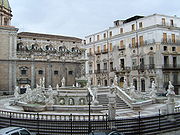
Francesco Camilliani
Encyclopedia

Tuscany
Tuscany is a region in Italy. It has an area of about 23,000 square kilometres and a population of about 3.75 million inhabitants. The regional capital is Florence ....
sculptor
Sculpture
Sculpture is three-dimensional artwork created by shaping or combining hard materials—typically stone such as marble—or metal, glass, or wood. Softer materials can also be used, such as clay, textiles, plastics, polymers and softer metals...
of the Renaissance
Renaissance
The Renaissance was a cultural movement that spanned roughly the 14th to the 17th century, beginning in Italy in the Late Middle Ages and later spreading to the rest of Europe. The term is also used more loosely to refer to the historical era, but since the changes of the Renaissance were not...
period. He studied in Florence under Baccio Bandinelli. His son Camillo Camilliani (died 1603) was later a sculptor too, working in Palermo
Palermo
Palermo is a city in Southern Italy, the capital of both the autonomous region of Sicily and the Province of Palermo. The city is noted for its history, culture, architecture and gastronomy, playing an important role throughout much of its existence; it is over 2,700 years old...
, where he also worked as an architect and held the post as well of ingegniere del Regno, "engineer to the Kingdom of Sicily".
Camilliani was praised in one of Cosimo Bartoli
Cosimo Bartoli
Cosimo Bartoli was an Italian diplomat, mathematician, philologist, and humanist. He worked and lived in Rome and Florence and took minor orders...
's Ragionamenti Accademici; in the course of a stroll through Florence the interlocutors in Bartoli's dialogue say of one of Camilliani's statues, that, had it been buried and rediscovered, it would have been praised heartily.
Francesco Camilliani's most notable work by far is the Renaissance fountain in the Piazza Pretoria in Palermo, the Fontana Pretoria. This piece was originally commissioned for the garden of the villa outside Florence of Luigi Alvarez de Toledo, son of the viceroy Don Pedro Álvarez de Toledo
Pedro Álvarez de Toledo
Don Pedro Álvarez de Toledo y Zúñiga, jure uxoris Marquis of Villafranca del Bierzo was the first effective Spanish viceroy of Naples, 1532 - 1552, responsible for considerable social, economic and urban change in the city and southern Italian kingdom, in general.-Early life:He was born in 1484...
and brother-in-law of Cosimo I de' Medici; it was completed in 1555. Camilliani was aided in the grand project by the garzoni of his studio, including the Florentine Michelangelo Naccherino (1550-1622), or Vagherino Fiorentino. In its original site, Giorgio Vasari
Giorgio Vasari
Giorgio Vasari was an Italian painter, writer, historian, and architect, who is famous today for his biographies of Italian artists, considered the ideological foundation of art-historical writing.-Biography:...
called it a "most stupendous fountain that has not its peer in Florence or perhaps in Italy." Under pressure to make economies in his style of living, and perhaps with reservations about the completed fountain's crowd of ignudi, in January 1573 Don Luigi permitted it to be bought by the Senate of Palermo, through the intervention of his brother Don Garçia, the former viceroy and Governor of Palermo. It was dismantled into six hundred and forty-four pieces and transported to Palermo, and set up there by Camillo Camilliani, who had to concentrate its elements in the more constricted urban space, and to oversee some additions to render it more suitable for Sicily, which included a Venus by Antonio Gagini. Re-erection at Palermo was complete in 1584. The sculpture of the fountain depicts fable
Fable
A fable is a succinct fictional story, in prose or verse, that features animals, mythical creatures, plants, inanimate objects or forces of nature which are anthropomorphized , and that illustrates a moral lesson , which may at the end be expressed explicitly in a pithy maxim.A fable differs from...
s, monsters, and nymph
Nymph
A nymph in Greek mythology is a female minor nature deity typically associated with a particular location or landform. Different from gods, nymphs are generally regarded as divine spirits who animate nature, and are usually depicted as beautiful, young nubile maidens who love to dance and sing;...
s all spraying jets of water, which also falls and cascades between them. Once locally known as the Fontana della Vergogna, the "fountain of shame”, because of the nude statues that stand around the base of each tier
Tier
TIER may refer to:* Taiwan Institute of Economic Research, one of two major economic research institutes in TaiwanTier may refer to:* a layer or ranking or classification-group in any real or imagined hierarchy...
, it is one of the few true pieces of High Renaissance art in Palermo.

